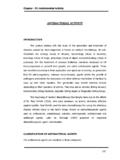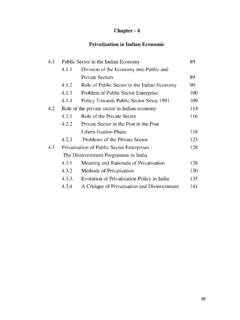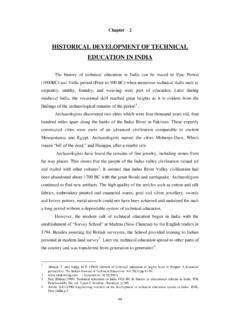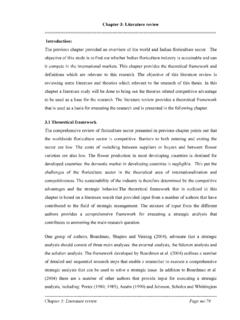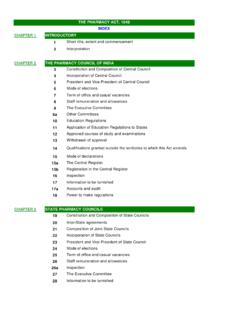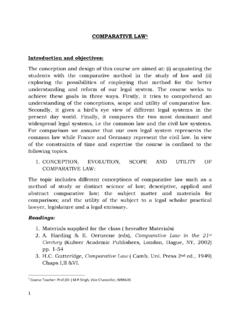Transcription of CHAPTER III - a reservoir of Indian theses
1 CHAPTER III HISTORY OF Indian BANKING: AN OVERVIEW 62 CHAPTER III HISTORY OF Indian BANKING - AN OVERVIEW In India, the banking system is as old as early Vedic period. The book of Manu contains reference regarding deposits advances, pledge policy of loan, and rate of interest. From the beginning of 20th century banking has been so developed that in fact, has come to be called LIFE BLOOD of trade and In India, banking has developed from the primitive stage to the modern system of banking in a fashion that has no parallel in the world history. With the dawn of independence, changes of vast magnitude have taken place in India. After independence India launched a process of planned economic activity in order to overcome the multitude of problems it faced as an underdeveloped nation.
2 The increasing tempo of economic activity lead to tremendous increase in the volume and complexity of banking activity. Therefore, the role of banks has had to expand at a fast As engines of development and vehicle of silent Socio-economic revolution in the country, Indian banks have assumed new responsibilities in the fields of geographical expansion, functional diversification and personal portfolio. Indian banking transformed itself from Class banking to Mass banking .3 63 The banking system, the most dominant segment of financial sector, accounts for over 80% of the funds flowing through the financial A banking sector performs three Primary functions in an economy: The operation of the payment system, the mobilization of savings and the allocation of savings to investment projects.
3 By allocating capital to the highest value use while limiting the risk and cost involved, the banking sector can exert a positive influence on the overall economy, and thus of broad macro economic The origin of the Indian banking industry may be traced to the establishment of bank of Bengal in Calcutta (now Kolkata) in 1786. The growth of banking industry in India may be studied in terms of two broad phases. Pre-independence (1786-1947) and Post-independence (1947 till date). The Post-independence phase may be further divided into three sub phases such as pre-nationalization period (1947-1969). Post nationalization period (1969 to 1991) and Post-liberalization period (1991 till date). Pre-Independence Era:- At the end of late 18th Century, there were hardly any bank in India in the modern sense of the term banks.
4 Some banks were opened at that time which functions as entities to finance industry, including speculative trade. With the large exposure to speculative ventures, most of the banks opened in India during that period could not survive and failed. The depositors lost 64 money and lost interest in keeping deposits with the bank. Subsequently, banking in India remain the exclusive domain of Europeans for the next several decades until the beginning of 20th Century. At the beginning of 20th Century, the Indian Economy was passing through a relative period of stability. Around five decades have elapsed since the India s first war of Indian independence and the social, industrial and other infrastructure have developed. At that time there were very small banks operated by indians and most of them were owned and operated by particular community.
5 The banking in India was controlled and dominated by the presidency banks, namely, The bank of Bombay, The bank of Bengal and the bank of Madras-which later on merged to form the imperial bank of India. The objectives of banks in the colonial era were mainly helping the colonial rulers in raising the resources for their empire building activities and facilitating training activities of the numerically small mercantile. India has a long history of both public and private banking. Modern banking in India began in the 18th century, with the founding of the English Agency House in Calcutta and Bombay. In the first half of the 19th Century three presidency banks were founded. After the 1860 introduction of limited liability, private banks began to appear and foreign banks entered into the markets.
6 The beginning of the 20th Century saw the introduction of Joint stock banks. In 1935, the presidency banks were merged together to form the 65 Imperial Bank of India, which was subsequently renamed the State Bank of India. Also that year, India s Central Bank, The Reserve Bank of India began operation6. When India emerged as an independent nation, it inherited a wartorn economy bedeviled by shortage of food grains, unemployment and the pangs of partition. The banking system, with shareholder orientation, was not well organized. The banks till then were discharging the functions of a traditional financial intermediary. To reorient them as instruments of economic change was indeed a stupendous task considering the narrow objective adopted by the banks at the time of Indian independence7 Post-Independence era:- With the dawn of Independence changes of vast magnitude have taken place in India.
7 At the time of Independence in 1947, the banking system in India was fairly well developed with over 600 commercial banks operating in the country. However soon after independence, the view that the banks from the colonial heritage were biased in favour of working capital loans for trade and large firms and against extending credit to small scale enterprises, agriculture and commoners, gained prominence. To ensure better coverage of banking needs of larger parts of economy and the rural constituencies, the Government of India nationalized the Imperial bank which was established in 1921 and transformed it into the State Bank of India with effect from 66 Despite the progress in 1950s and 1960s, it was felt that the creation of SBI was not far reaching enough since the banking needs of small scale industries and the agricultural structure was still not covered sufficiently.
8 This was partially due to the existing close ties commercial and industry houses maintained with the established commercial banks, which give them an advantage in obtaining Additionally, there was a perception that banks should play a more prominent rule in India s development strategy by mobilizing resources for sectors that were seen as crucial for economic As a result, the policy of social control over banks was announced. Its aim was to cause changes in the management and distribution of credit by commercial Nationalization The post war development strategy was in many ways a socialist one and Indian Government felt that banks in private hands didn t lend enough to those who needed it most. In July 1969, the Government nationalized all 14 banks whose national wise deposits were greater than Rs.
9 500 million, resulting in the nationalization of 54 percent more of branches in India and bringing the total number of branches under Government control to 84 percent. Prakash Tandon, former chairman of the Punjab National Bank (nationalized in 1969) describes the rationale of nationalization as 67 Many bank failures and crisis over the two centuries, and the damage they did under laissez faire conditions; the needs of planned growth and equitable distribution of credit, which in privately owned banks was concentrated mainly on controlling industrial houses and influential borrowers; the needs of growing small scale industries and farming regarding finance, equipments and inputs; from all these there emerged and inexorable demand for banking legislation, some government control and a Central banking authority, adding up, in the financial analysis, to social control and nationalization.
10 The bank nationalization in July 1969 with its objective to Control the commanding heights of the economy and to meet progressively the needs of development of the economy in conformity with the national policy and objectives served to intensify the social objective of ensuring that financial intermediaries fully met the credit demands for the productive purposes. Two significant purposes of nationalization were rapid branch expansion and channeling of credit according to the plan priorities. To meet the broad objective, banking facilities were made available in hitherto uncovered areas, so as to enable them to not only mop up potential savings and meet the credit gaps in agriculture and small scale industries, thereby helping to bring large areas of economic activities with in the organized banking system.
